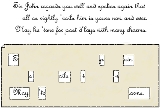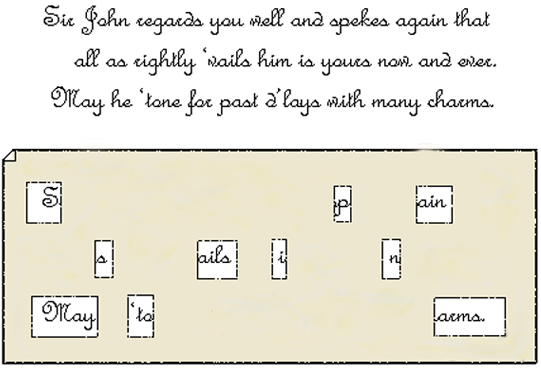
Cardan grille
Encyclopedia
History
In 1550, Girolamo Cardano (1501-1576), known in French as Jérôme Cardan, proposed a simple grid for writing hidden messages. He intended to cloak his messages inside an ordinary letter so that the whole would not appear to be a cipher at all.Such a disguised message is considered to be an example of steganography
Steganography
Steganography is the art and science of writing hidden messages in such a way that no one, apart from the sender and intended recipient, suspects the existence of the message, a form of security through obscurity...
, which is a sub-branch of general cryptography
Cryptography
Cryptography is the practice and study of techniques for secure communication in the presence of third parties...
. But the name Cardan was applied to grilles that may not have been Cardan's invention, and, so, Cardan is a generic name for cardboard grille ciphers.
Cardinal Richelieu (1585-1642) was reputed to be fond of the Cardan grille and to have used it in both private and diplomatic correspondence. Educated men in 17th century Europe
Europe
Europe is, by convention, one of the world's seven continents. Comprising the westernmost peninsula of Eurasia, Europe is generally 'divided' from Asia to its east by the watershed divides of the Ural and Caucasus Mountains, the Ural River, the Caspian and Black Seas, and the waterways connecting...
were familiar with word games in literature, including acrostics, anagram
Anagram
An anagram is a type of word play, the result of rearranging the letters of a word or phrase to produce a new word or phrase, using all the original letters exactly once; e.g., orchestra = carthorse, A decimal point = I'm a dot in place, Tom Marvolo Riddle = I am Lord Voldemort. Someone who...
s, and ciphers.
Although the original Cardan grilles were little used by the end of the 17th century, they still appeared occasionally in the form of masked letters and as literary curiosities. George Gordon Byron, for example, claimed to have formed a verse around a Cardan grille message – but as a demonstration of verbal skill rather than a serious cipher.
Alternative grilles possess apertures for single letters only and can be used quickly. Messages are filled out with a jumble of letters or numbers and are clearly cryptograms whereas Cardano intended to create steganograms.
These single-letter grilles may be named after Cardano, but they are also called simply cardboard ciphers.
A further variation is a turning grille or trellis
Trellis
Trellis may refer to:* Trellis Drainage System* Trellis , an architectural structure often used to support plants* Trellis , a special kind of graph, often used in coding...
, based on the chess board, which was used in the latter 16th century.
The turning grille reappeared in a more sophisticated form at the end of the 19th century; but, by this time, any connection with Cardano was in name alone.
Construction

An encipherer places the grille on a sheet of paper and writes his message in the rectangular apertures, some of which might allow a single letter, a syllable, or a whole word. Then, removing the grille, the fragments are filled out to create a note or letter that disguises the true message. Cardano suggested drafting the text three times in order to smooth any irregularities that might indicate the hidden words.
The recipient of the message must possess an identical grille. Copies of grilles are cut from an original template, but many different patterns could be made for one-to-one correspondence.
The grille can be placed in four positions – face up and face down, upright and reversed – which increases the number of possible cell positions fourfold.

Francis Bacon
Francis Bacon, 1st Viscount St Albans, KC was an English philosopher, statesman, scientist, lawyer, jurist, author and pioneer of the scientific method. He served both as Attorney General and Lord Chancellor of England...
. But the task was easier for Cardano, because 16th century spelling was not standardised and left much room for contractions and adornments of penmanship.
Detection of messages
When executed badly, a Cardan message stands out because of stilted language and uneven writing. An analyst may attempt to reconstruct the grille when there are several examples of suspect messages from a correspondent.When executed well, a Cardan message can be difficult to spot. Even when an analyst suspects the presence of a message, an innocent letter can contain apparently hidden text. So, in practice, the only solution is to obtain the grille itself.
Disadvantages
The method is slow and requires literary skill. Above all, any physical cipher device is subject to loss, theft and seizure; so to lose one grille is to lose all secret correspondence constructed with that grille. Possession of a grille may be incriminating.The Cardan Grille, in its original form, is of more literary than cryptographic interest. For example, controversy surrounds the Voynich manuscript
Voynich manuscript
The Voynich manuscript, described as "the world's most mysterious manuscript", is a work which dates to the early 15th century, possibly from northern Italy. It is named after the book dealer Wilfrid Voynich, who purchased it in 1912....
which could be a 16th century fake cipher text, possibly constructed with a Cardan grille which was used to generate pseudo-random nonsense from a pre-existing text.

